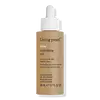What's inside
What's inside
 Key Ingredients
Key Ingredients

 Benefits
Benefits

 Concerns
Concerns

 Ingredients Side-by-side
Ingredients Side-by-side

C13-15 Alkane
SolventIsohexadecane
EmollientIsododecane
EmollientIsoamyl Laurate
EmollientEthylene/Propylene/Styrene Copolymer
C9-12 Alkane
SolventHippophae Rhamnoides Fruit Oil
Skin ProtectingHelianthus Annuus Seed Oil
EmollientCoco-Caprylate/Caprate
EmollientBrassica Campestris/Aleurites Fordi Oil Copolymer
Skin ConditioningCitrullus Lanatus Seed Oil
EmollientMoringa Oleifera Seed Oil
EmollientSimmondsia Chinensis Seed Oil
EmollientOrbignya Oleifera Seed Oil
EmollientPhytosteryl/Octyldodecyl Lauroyl Glutamate
Skin ConditioningButylene/Ethylene/Styrene Copolymer
Amaranthus Caudatus Seed Extract
Skin ConditioningDiisostearyl Malate
EmollientParfum
MaskingCitronellol
PerfumingLimonene
PerfumingCitral
PerfumingLinalool
PerfumingPentaerythrityl Tetra-Di-T-Butyl Hydroxyhydrocinnamate
AntioxidantC13-15 Alkane, Isohexadecane, Isododecane, Isoamyl Laurate, Ethylene/Propylene/Styrene Copolymer, C9-12 Alkane, Hippophae Rhamnoides Fruit Oil, Helianthus Annuus Seed Oil, Coco-Caprylate/Caprate, Brassica Campestris/Aleurites Fordi Oil Copolymer, Citrullus Lanatus Seed Oil, Moringa Oleifera Seed Oil, Simmondsia Chinensis Seed Oil, Orbignya Oleifera Seed Oil, Phytosteryl/Octyldodecyl Lauroyl Glutamate, Butylene/Ethylene/Styrene Copolymer, Amaranthus Caudatus Seed Extract, Diisostearyl Malate, Parfum, Citronellol, Limonene, Citral, Linalool, Pentaerythrityl Tetra-Di-T-Butyl Hydroxyhydrocinnamate
Isododecane
EmollientDimethicone
EmollientDimethiconol
EmollientCamellia Oleifera Seed Oil
Skin ConditioningZea Mays Germ Oil
EmollientArgania Spinosa Kernel Oil
EmollientSclerocarya Birrea Seed Oil
HumectantPentaclethra Macroloba Seed Oil
EmollientCaprylic/Capric Triglyceride
MaskingCamelina Sativa Seed Oil
Skin ConditioningLinalool
PerfumingAlpha-Isomethyl Ionone
PerfumingLimonene
PerfumingCoumarin
PerfumingBenzyl Alcohol
PerfumingCamellia Japonica Flower Extract
EmollientPhyllanthus Emblica Fruit Extract
HumectantTocopherol
AntioxidantParfum
MaskingIsododecane, Dimethicone, Dimethiconol, Camellia Oleifera Seed Oil, Zea Mays Germ Oil, Argania Spinosa Kernel Oil, Sclerocarya Birrea Seed Oil, Pentaclethra Macroloba Seed Oil, Caprylic/Capric Triglyceride, Camelina Sativa Seed Oil, Linalool, Alpha-Isomethyl Ionone, Limonene, Coumarin, Benzyl Alcohol, Camellia Japonica Flower Extract, Phyllanthus Emblica Fruit Extract, Tocopherol, Parfum
 Reviews
Reviews

Ingredients Explained
These ingredients are found in both products.
Ingredients higher up in an ingredient list are typically present in a larger amount.
Isododecane is a fragrance, emollient, and solvent.
As an emollient, it helps your skin stay soft and hydrated. Emollients help trap moisture into your skin.
Isododecane's role as a solvent makes it a great texture enhancer. It spreads smoothly on skin and does not leave a sticky feeling behind. Isododecane also helps prevent color transfer in makeup products.
Isododecane is not absorbed into skin.
Learn more about IsododecaneLimonene is a fragrance that adds scent and taste to a formulation.
It's found in the peel oil of citrus fruits and other plants such as lavender and eucalyptus. The scent of limonene is generally described as "sweet citrus".
Limonene acts as an antioxidant, meaning it helps neutralize free radicals.
When exposed to air, oxidized limonene may sensitize the skin. Because of this, limonene is often avoided by people with sensitive skin.
The term 'fragrance' is not regulated in many countries. In many cases, it is up to the brand to define this term. For instance, many brands choose to label themselves as "fragrance-free" because they are not using synthetic fragrances. However, their products may still contain ingredients such as essential oils that are considered a fragrance.
Learn more about LimoneneLinalool is a fragrance and helps add scent to products. It's derived from common plants such as cinnamon, mint, citrus, and lavender.
Like Limonene, this ingredient oxidizes when exposed to air. Oxidized linalool can cause allergies and skin sensitivity.
This ingredient has a scent that is floral, spicy tropical, and citrus-like.
Learn more about LinaloolParfum is a catch-all term for an ingredient or more that is used to give a scent to products.
Also called "fragrance", this ingredient can be a blend of hundreds of chemicals or plant oils. This means every product with "fragrance" or "parfum" in the ingredients list is a different mixture.
For instance, Habanolide is a proprietary trade name for a specific aroma chemical. When used as a fragrance ingredient in cosmetics, most aroma chemicals fall under the broad labeling category of “FRAGRANCE” or “PARFUM” according to EU and US regulations.
The term 'parfum' or 'fragrance' is not regulated in many countries. In many cases, it is up to the brand to define this term.
For instance, many brands choose to label themselves as "fragrance-free" because they are not using synthetic fragrances. However, their products may still contain ingredients such as essential oils that are considered a fragrance by INCI standards.
One example is Calendula flower extract. Calendula is an essential oil that still imparts a scent or 'fragrance'.
Depending on the blend, the ingredients in the mixture can cause allergies and sensitivities on the skin. Some ingredients that are known EU allergens include linalool and citronellol.
Parfum can also be used to mask or cover an unpleasant scent.
The bottom line is: not all fragrances/parfum/ingredients are created equally. If you are worried about fragrances, we recommend taking a closer look at an ingredient. And of course, we always recommend speaking with a professional.
Learn more about Parfum